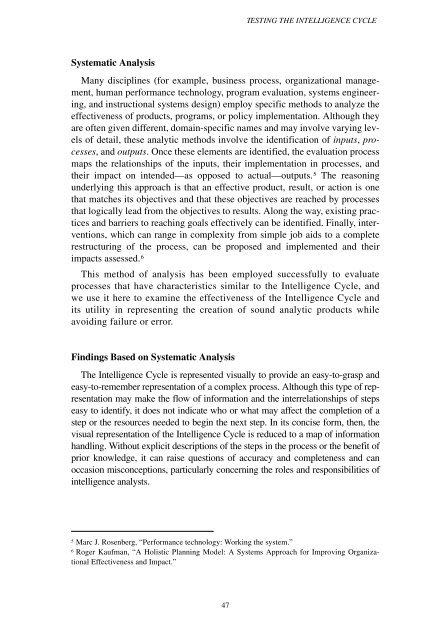Analytic Culture in the U.S. Intelligence Community (PDF) - CIA
Analytic Culture in the U.S. Intelligence Community (PDF) - CIA
Analytic Culture in the U.S. Intelligence Community (PDF) - CIA
Create successful ePaper yourself
Turn your PDF publications into a flip-book with our unique Google optimized e-Paper software.
TESTING THE INTELLIGENCE CYCLE<br />
Systematic Analysis<br />
Many discipl<strong>in</strong>es (for example, bus<strong>in</strong>ess process, organizational management,<br />
human performance technology, program evaluation, systems eng<strong>in</strong>eer<strong>in</strong>g,<br />
and <strong>in</strong>structional systems design) employ specific methods to analyze <strong>the</strong><br />
effectiveness of products, programs, or policy implementation. Although <strong>the</strong>y<br />
are often given different, doma<strong>in</strong>-specific names and may <strong>in</strong>volve vary<strong>in</strong>g levels<br />
of detail, <strong>the</strong>se analytic methods <strong>in</strong>volve <strong>the</strong> identification of <strong>in</strong>puts, processes,<br />
and outputs. Once <strong>the</strong>se elements are identified, <strong>the</strong> evaluation process<br />
maps <strong>the</strong> relationships of <strong>the</strong> <strong>in</strong>puts, <strong>the</strong>ir implementation <strong>in</strong> processes, and<br />
<strong>the</strong>ir impact on <strong>in</strong>tended—as opposed to actual—outputs. 5 The reason<strong>in</strong>g<br />
underly<strong>in</strong>g this approach is that an effective product, result, or action is one<br />
that matches its objectives and that <strong>the</strong>se objectives are reached by processes<br />
that logically lead from <strong>the</strong> objectives to results. Along <strong>the</strong> way, exist<strong>in</strong>g practices<br />
and barriers to reach<strong>in</strong>g goals effectively can be identified. F<strong>in</strong>ally, <strong>in</strong>terventions,<br />
which can range <strong>in</strong> complexity from simple job aids to a complete<br />
restructur<strong>in</strong>g of <strong>the</strong> process, can be proposed and implemented and <strong>the</strong>ir<br />
impacts assessed. 6<br />
This method of analysis has been employed successfully to evaluate<br />
processes that have characteristics similar to <strong>the</strong> <strong>Intelligence</strong> Cycle, and<br />
we use it here to exam<strong>in</strong>e <strong>the</strong> effectiveness of <strong>the</strong> <strong>Intelligence</strong> Cycle and<br />
its utility <strong>in</strong> represent<strong>in</strong>g <strong>the</strong> creation of sound analytic products while<br />
avoid<strong>in</strong>g failure or error.<br />
F<strong>in</strong>d<strong>in</strong>gs Based on Systematic Analysis<br />
The <strong>Intelligence</strong> Cycle is represented visually to provide an easy-to-grasp and<br />
easy-to-remember representation of a complex process. Although this type of representation<br />
may make <strong>the</strong> flow of <strong>in</strong>formation and <strong>the</strong> <strong>in</strong>terrelationships of steps<br />
easy to identify, it does not <strong>in</strong>dicate who or what may affect <strong>the</strong> completion of a<br />
step or <strong>the</strong> resources needed to beg<strong>in</strong> <strong>the</strong> next step. In its concise form, <strong>the</strong>n, <strong>the</strong><br />
visual representation of <strong>the</strong> <strong>Intelligence</strong> Cycle is reduced to a map of <strong>in</strong>formation<br />
handl<strong>in</strong>g. Without explicit descriptions of <strong>the</strong> steps <strong>in</strong> <strong>the</strong> process or <strong>the</strong> benefit of<br />
prior knowledge, it can raise questions of accuracy and completeness and can<br />
occasion misconceptions, particularly concern<strong>in</strong>g <strong>the</strong> roles and responsibilities of<br />
<strong>in</strong>telligence analysts.<br />
5<br />
Marc J. Rosenberg, “Performance technology: Work<strong>in</strong>g <strong>the</strong> system.”<br />
6<br />
Roger Kaufman, “A Holistic Plann<strong>in</strong>g Model: A Systems Approach for Improv<strong>in</strong>g Organizational<br />
Effectiveness and Impact.”<br />
47
















